“Those little green bugs are everywhere again!” If you’ve found yourself frustrated by mysterious holes in your prized tomato leaves or noticed your squash plants suddenly wilting, you’re facing one of gardening’s most persistent challenges. Garden pests can quickly transform your flourishing plants into a buffet if left unchecked.
Let’s explore what’s likely munching on your garden and how to address it effectively.
Why Natural Remedies Aren’t Always Enough
Many gardeners turn to DIY solutions like essential oils, homemade sprays, or companion planting to manage pests. While these natural approaches can help deter insects temporarily, they rarely solve the underlying problem. Most home remedies wear off quickly after rain or irrigation, and pests often develop resistance or simply move to untreated areas of your garden.
Diatomaceous earth and neem oil can be helpful when used correctly, but they’re not long-term fixes. They need frequent reapplication and can be washed away easily, leaving your plants vulnerable again within days.
Professional Protection: Effective, Friendly Garden Pest Solutions

At Alta Pest Control, we’ve developed an approach that keeps garden pests at bay without compromising your plants’ health. Rather than applying treatments directly to your vegetables and flowers, we create a protective barrier around your garden’s perimeter. This strategic application, combined with specially formulated granules that activate with water, targets pests at their source without touching your edible plants.
We believe in honest communication, long-term solutions, and treating your outdoor space with the same care you do. When you work with us, you’ll get:
- Straightforward Conversations: We don’t overcomplicate things. We’ll talk you through what we’re doing, why we’re doing it, and what to expect — no guesswork.
- Knowledgeable Technicians: Our team knows what pests are common in your area, what’s seasonal, and how to protect your garden without overdoing it.
- Thoughtful Treatments: We use high-impact products that are friendly for families, pets, and plants — so you don’t have to worry about harming your space just to deal with bugs.
- Consistent, Year-Round Support: With our quarterly pest control plan, we help keep your yard protected through every season. No one-time sprays. No short-term fixes.
- A Better Experience: We’re not just here to eliminate pests — we’re here to provide peace of mind, clear communication, and a better way to handle pest control.
Your garden matters. Let’s help it thrive together. See if we service your area.
10 Common Garden Pests and How to Get Rid of Them
Below are 10 of the most common garden pests, how to identify them, and what you can try at home. While some small problems can be managed temporarily, recurring or severe infestations are usually best handled by a professional. Knowing what you’re up against is the first step.
1. Aphids
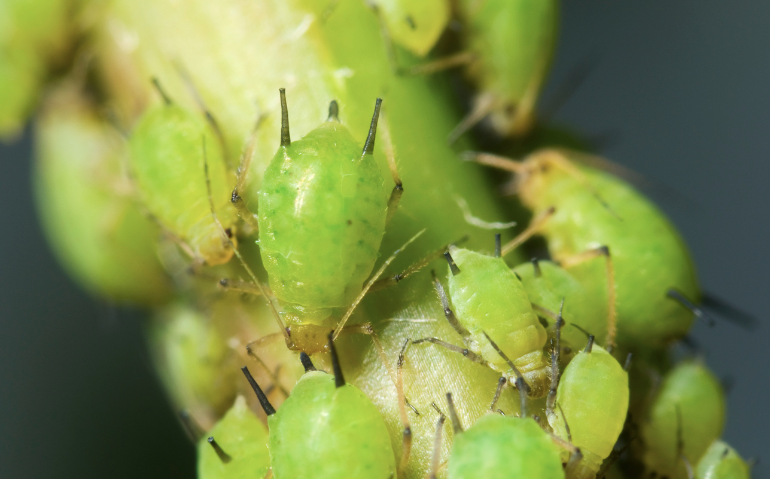
Identification: These tiny, soft-bodied insects cluster underneath leaves and along stems. They come in various colors—green, black, yellow, or red—and reproduce rapidly.
Impact: As aphids feed, they drain plant sap, causing leaves to curl, yellow, and stunt new growth. The sticky residue they leave behind (honeydew) attracts ants and promotes sooty mold.
Organic Solutions: A strong blast of water can knock colonies off plants temporarily. Insecticidal soaps and neem oil provide short-term control, and introducing ladybugs can help if your garden is enclosed.
2. Cutworms
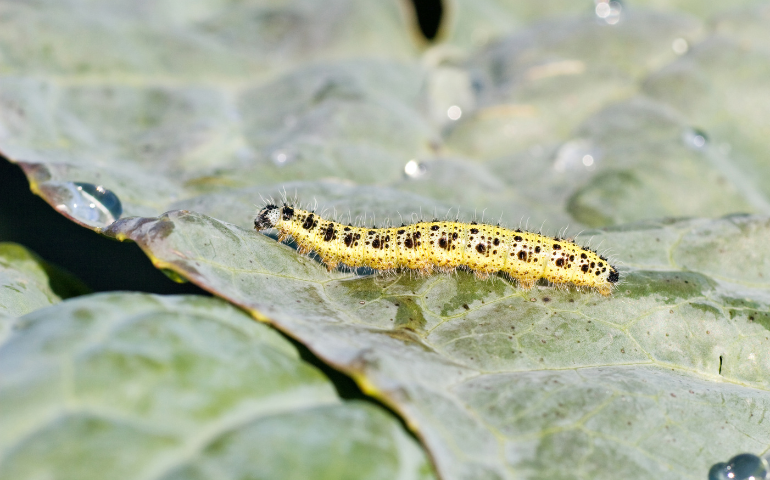
Identification: These night-feeding caterpillars hide in soil during daylight hours. When disturbed, they curl into a distinctive C-shape and are typically gray or brown.
Impact: Cutworms are notorious for cutting down young seedlings at the soil line, sometimes destroying entire rows overnight without warning.
Organic Solutions: Placing cardboard collars around tender seedlings creates a physical barrier. Coffee grounds or crushed eggshells scattered around plants may deter them temporarily, but require refreshing after rain.
3. Cabbage Worms
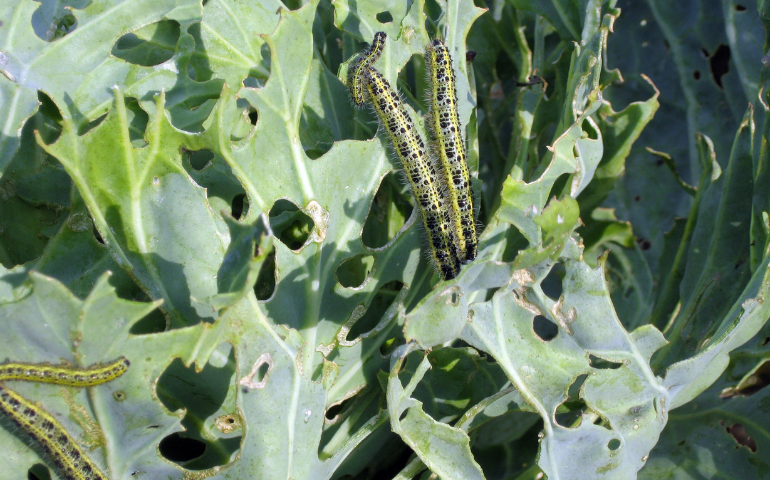
Identification: You’ll spot these velvety green caterpillars munching on leaves, sometimes alongside their tiny green droppings. The parent butterflies are white with black spots.
Impact: They create irregular holes throughout leaves of cabbage family plants (kale, broccoli, cauliflower), sometimes working their way into the center heads.
Organic Solutions: Bacillus thuringiensis (Bt) spray affects caterpillars specifically but needs weekly reapplication. Row covers can prevent butterflies from laying eggs but must be removed during flowering for pollination.
4. Leafminers
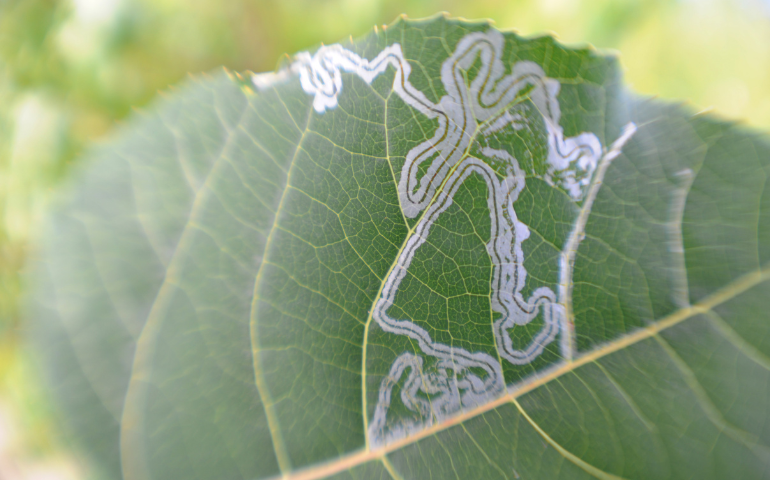
Identification: You’ll notice winding, snake-like trails or tunnels through leaves where larvae have fed between leaf surfaces.
Impact: While mostly cosmetic, heavy infestations reduce plants’ photosynthesis capability and can weaken overall plant health.
Organic Solutions: Removing affected leaves helps prevent spread. Sticky yellow traps can catch adult flies, but complete control often requires persistence across multiple life cycles.
5. Mealybugs
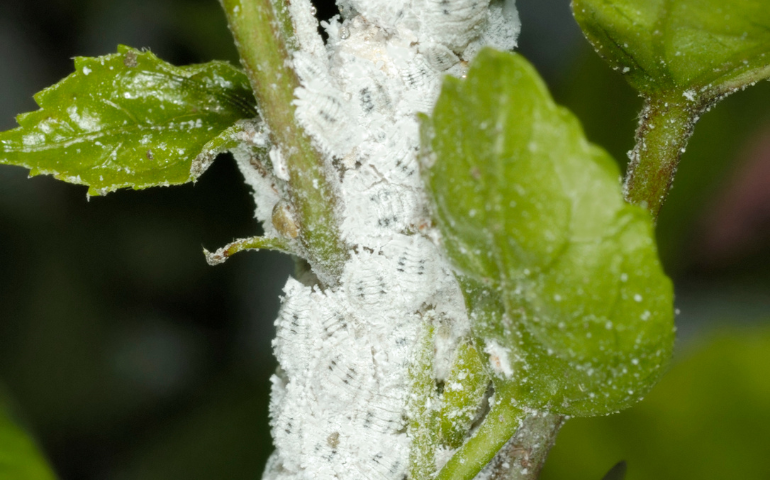
Identification: These pests appear as cottony white masses clustering in leaf joints and undersides. Their waxy coating makes them somewhat resistant to treatments.
Impact: Mealybugs suck plant juices, causing yellowing leaves, stunted growth, and potential plant death if infestations become severe.
Organic Solutions: For houseplants or small garden areas, dabbing with alcohol-soaked cotton swabs can be effective. Insecticidal soaps need to penetrate their waxy coating to work, often requiring multiple applications.
6. Slugs and Snails
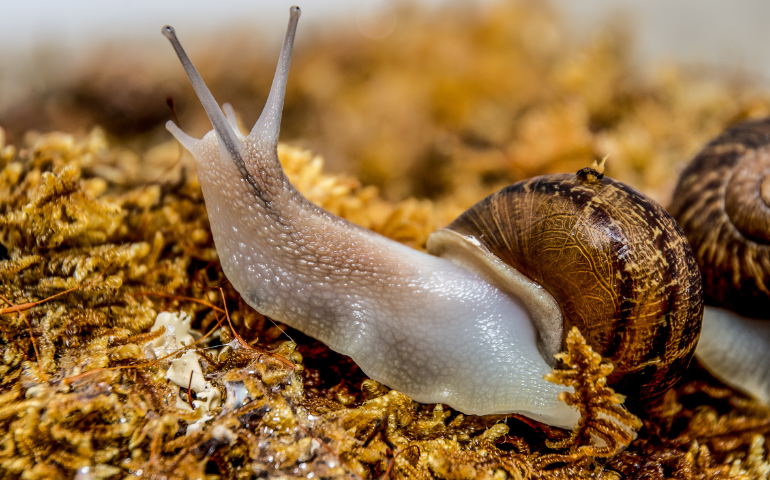
Identification: The telltale slime trails and large, irregular holes in leaves—especially near the ground—signal slugs and snails are present. They’re most active during the night in damp, cool conditions.
Impact: They can devour seedlings overnight and cause significant damage to leafy greens, hostas, and strawberries.
Organic Solutions: Beer traps attract and drown them, while copper tape creates barriers they won’t cross. Diatomaceous earth works temporarily but becomes ineffective when wet, requiring constant replacement.
7. Spider Mites
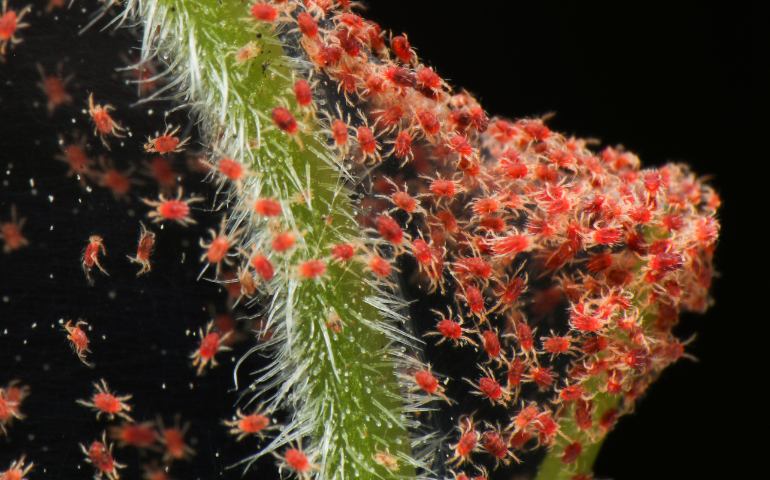
Identification: These nearly microscopic pests create fine webbing between leaves and stems. Infested leaves develop a stippled, yellowish appearance as mites pierce cells to feed.
Impact: Spider mites thrive in hot, dry conditions, rapidly reproducing and causing bronzing, yellowing, and premature leaf drop. Infestations can quickly spread throughout a garden.
Organic Solutions: Increasing humidity through regular misting helps prevent populations from exploding. Insecticidal soaps and neem oil provide some control but must reach the undersides of leaves where mites congregate.
8. Squash Vine Borers
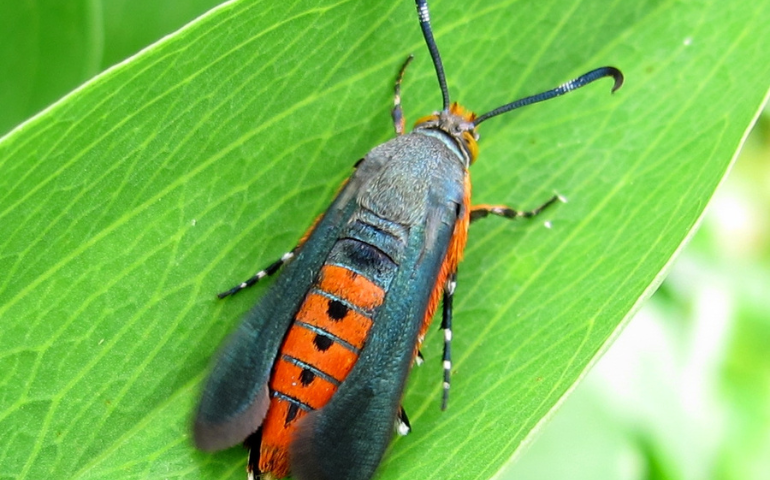
Identification: Signs include wilting vines despite adequate watering and small holes near plant bases, often with sawdust-like material (frass) pushed out.
Impact: The larvae tunnel through squash stems, disrupting water and nutrient transport. Once symptoms appear, plants often collapse within days.
Organic Solutions: Wrapping stems with aluminum foil creates a physical barrier. Injecting Bt into stems at the first sign of frass might save plants if caught early, but prevention is key with these destructive pests.
9. Tomato Hornworms
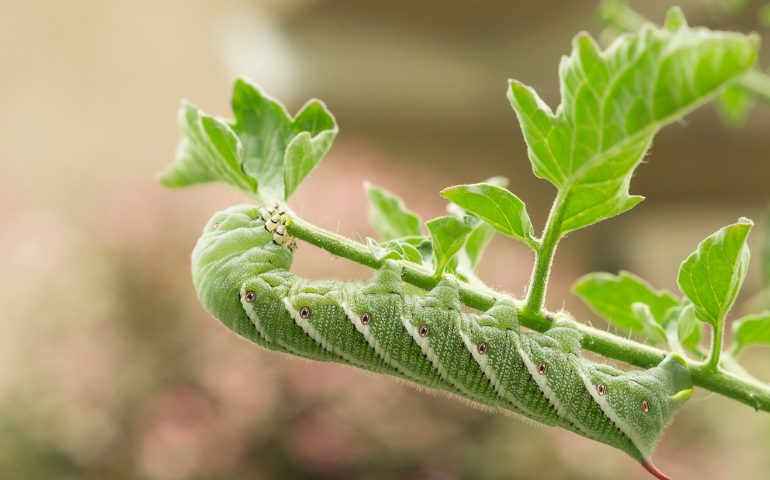
Identification: These large green caterpillars (up to 4 inches long) blend remarkably well with tomato foliage. Look for bare stems, black droppings, and their distinctive horn-like tail projection.
Impact: Their voracious appetite can defoliate tomato plants with shocking speed. Their size allows them to consume large amounts of foliage daily.
Organic Solutions: Handpicking remains most effective—despite their intimidating size, they’re harmless to humans.
10. Japanese Beetles
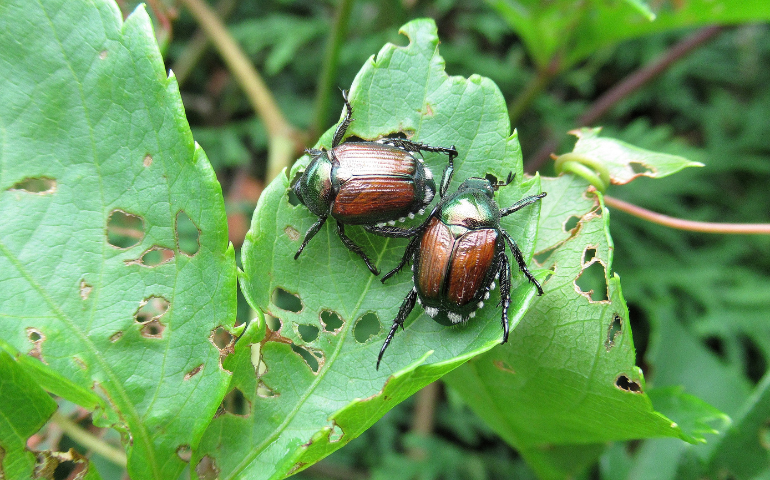
Identification: These metallic blue-green and copper beetles are unmistakable with their oval shape and approximately half-inch size.
Impact: Japanese Beetles skeletonize leaves by eating tissue between veins and can destroy flowers completely. They often feed in groups, magnifying damage.
Organic Solutions: Handpicking in early morning when they’re sluggish can help reduce numbers. Milky spore applied to lawns targets the grub stage but takes years to establish effectively.
Prevention Strategies for a Healthier Garden
While treating active invasions is necessary, preventing garden pest problems delivers better results with less effort:
- Rotate annual vegetables to different garden sections each year
- Remove garden debris promptly after harvest
- Perform regular plant inspections—especially leaf undersides
- Water in the morning to reduce humidity and fungal issues
- Apply appropriate mulch to deter soil-dwelling pests
- Select resistant varieties developed for your region
Your local environment plays a significant role in pest activity too. Tailoring your pest prevention strategy to your specific region and habits is crucial. For example, desert gardeners battle different pests than those in rainy climates, and urban gardens face different challenges than rural ones.
In coastal regions where seafood is a staple—fresh lobster, crab, shrimp, and other shellfish—gardens often face unique challenges. The combination of humid, salty air creates perfect conditions for certain pests, while discarded seafood waste can attract unwanted visitors to your yard.
Similarly, other food waste requires careful management to prevent pest issues. Meat scraps, dairy products, and oily foods can attract a variety of pests when composted improperly. Even seemingly innocent vegetable scraps like tomato seeds and fruit peels can germinate unwanted plants or attract fruit flies and other insects.
Many gardeners don’t realize that tossing shellfish remains in outdoor compost bins can draw in raccoons, rats, and insects that may then discover your garden. Consider using sealed compost systems or disposing of seafood waste through municipal services instead.
Most importantly, implementing quarterly professional pest control creates a consistent protective barrier that prevents pests from establishing themselves in the first place. Our treatments target the perimeter of your garden and landscape, creating a shield that stops problems before they reach your precious plants.
The Alta Pest Control Difference
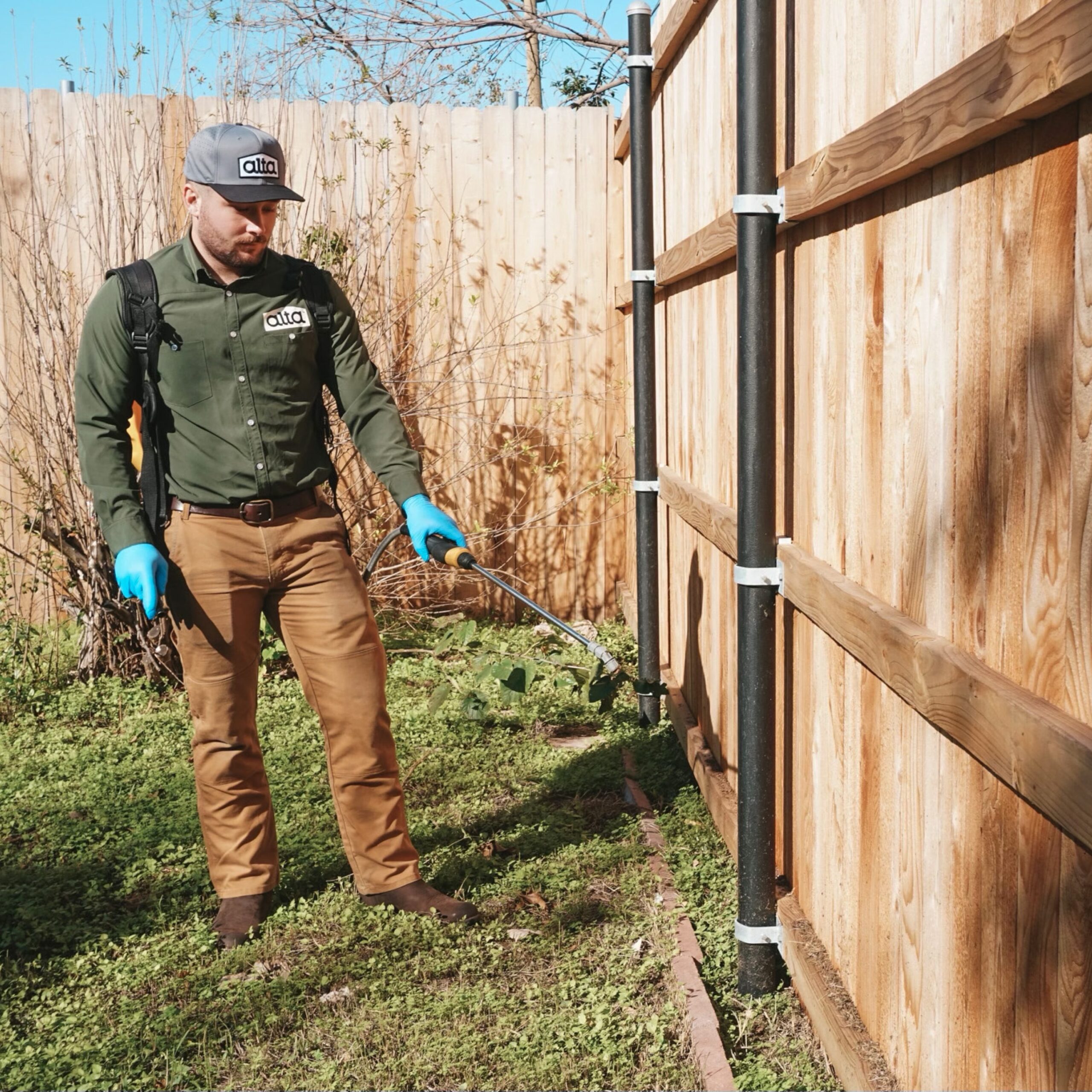
Rather than saturating your edible plants with chemicals, our approach focuses on strategic application around your garden’s perimeter. This creates an invisible boundary that intercepts pests before they reach your vegetables, fruits, and flowers.
Our child and pet-friendly services are designed specifically to protect your garden while respecting the beneficial insects—like pollinators—that help your plants thrive. The granular products we apply to your yard activate with water and are carried back to nests by pests, eliminating colonies at their source.
With our quarterly treatment schedule, your garden remains protected throughout the growing season. And if pests reappear between visits, we’ll return at no extra cost—that’s our satisfaction guarantee.
Let’s protect your garden the right way. Contact Alta Pest Control today at 866-201-7787 to schedule your first service and enjoy a thriving, productive garden all season long.
Share article:
